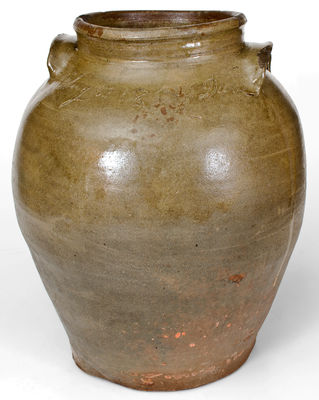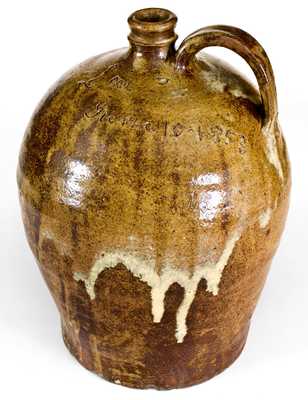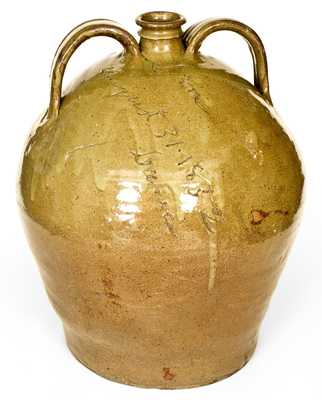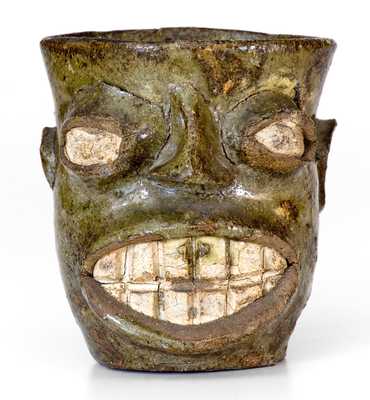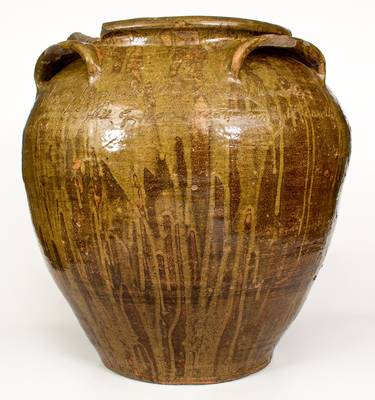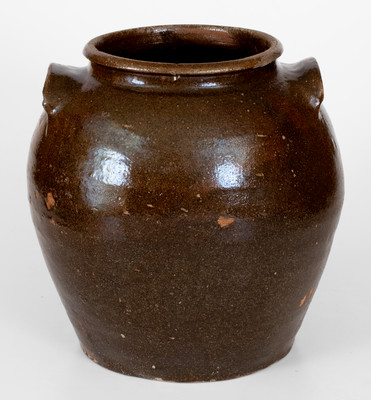Possibly Unique Two-Gallon Alkaline-Glazed Stoneware Jug, Inscribed and Dated "2 Gallons / Made by / Horne + Devore / Kirksey's X Roads / Edgefield County / So. Ca. / July 30th 1874," William Horne and John Devore at the Jesse P. Bodie Pottery, Kirksey's Crossroads, Edgefield District, SC, 1874, ovoid jug with semi-rounded spout and olive-colored alkaline glaze, featuring a lengthy incised inscription bearing the signature of cooperative potters, William Horne and John Devore, along with the pottery location, "Kirksey's X [Cross]Roads," the county and state of production, "Edgefield County / So. Ca.," and date of manufacture, "July 30th 1874." This jug is the only documented work signed by this potting duo, both employed by well-known Edgefield pottery owner, Jesse P. Bodie, in existence. Horne and Devore are discussed at the length in Cinda K. Baldwin's book, Great and Noble Jar. As noted by Baldwin, a William Horn is listed in the 1870 U.S. Federal Census as a twenty-two-year-old living at the "Kirksey's X Roads" post office with occupation of "work in Potry(sic)." Jonathan Devore, age forty-three, was listed as a farmer living next door to the Horn family. Baldwin refers to a 1920 interview with John Devore's son, William J. Devore, in which he stated that his father turned at the Roundtree and Bodie pottery directly after the Civil War until its closing. John Devore is also listed in the 1860 census as living next to W.D. Roundtree, Bodie's predecessor at the pottery, with an occupation of "overseer." This jug offers rare insight into the relationship of workers at 19th century American potteries in that it indicates a cooperative effort on the production of even relatively small pieces, in this case, two gallons in capacity. This "time capsule in clay" to the day of July 30th, 1874 suggests Horne and Devour made a series of pieces together, with one turning, and another possibly trimming and glazing the pots, with this one surviving jug commemorating the day's production. Outside of the work of David Drake, it ranks among the most heavily-inscribed pieces of Edgefield stoneware known. Literature: Illustrated and discussed in Baldwin, Great and Noble Jar, pp. 103-104 ; Provenance: Ex-Collection of Tony and Marie Shank. Restored handle. A small, restored oblong hole at shoulder. Otherwise excellent condition. H 14 3/8".















